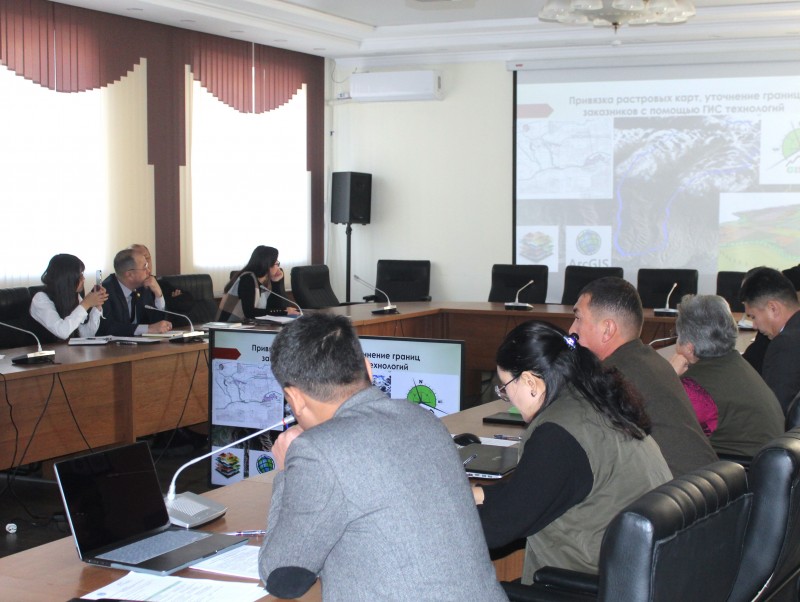
The СAMР Alatoo РF has presented the results of field research on the nature reserves of Issyk-Kul Oblast. The meeting was attended by representatives from the Ministry of Natural Resources, Ecology, and Technical Supervision of the Kyrgyz Republic (MNRETS), the Forestry Service under the Ministry of Emergency Situations, scientists from the National Academy of Sciences of Kyrgyzstan, and staff from protected natural areas.
Opening the event, Azamat Kenzhebaev, Director of the Department for Biodiversity Conservation and Protected Areas under MNRETS, highlighted that there are currently 64 reserves in Kyrgyzstan, according to the latest inventory. However, these figures might be inaccurate.
“Issues related to nature reserves were bound to be raised sooner or later, and it is good that we are discussing this important topic today. Our country has different types of reserves — temporary and long-term. Science should play a key role in working with them. We appeal to university leaders to send students to conduct research in reserves and collect data on the state of flora and fauna,” Kenzhebaev said.
Most reserves were established during the Soviet era. During the transitional period, their existence was either neglected or insufficiently studied. Thus, conducting an inventory is a vital step. Specialists from СAMР Alatoo РF and scientists from the National Academy of Sciences of Kyrgyzstan, with support from the Issyk-Kul Biosphere Reserve Directorate, assessed the condition of natural resources and biodiversity in the reserves, clarified their boundaries using GIS technologies, identified current problems, and proposed recommendations. They emphasized that reserves play a crucial role in protecting key natural complexes in Issyk-Kul Oblast and require enhanced management and monitoring.
Out of 11 protected zones in Issyk-Kul Oblast, the following reserves were studied: Kensuu, Tyup, Jeti-Oguz, Teploklyuchenka, Small Aksu, Baitamtal, Dolon, “Barskoon Waterfall,” and “Jeti-Oguz Rocks.” These areas were established during the Soviet period to protect rare species such as roe deer, maral deer, ibex, and snow leopard, as well as to restore game animals and protect unique ecosystems (mixed and spruce forests, alpine meadows). Currently, these reserves are active and cover almost 1.15 million hectares in Issyk-Kul Oblast.
Experts from СAMР Alatoo РF summarized the problems faced by these reserves and highlighted the following: (1) lack of clear boundaries; (2) weak protection due to insufficient staff of rangers; (3) high anthropogenic pressure; (4) lack of systematic information needed for effective management.
Askar Davletbakov, a representative of the National Academy of Sciences of Kyrgyzstan, noted that land-use practices have a significant negative impact on flora and fauna in the reserves. “Livestock grazing, deforestation, and man-made fires for pasture expansion are the most pressing issues. Although the law allows only lightweight structures, in reality, vacation homes are being constructed despite the reserves’ status,” he said. Davletbakov also drew attention to the fact that the new version of the law on protected areas has reduced the role of scientific activities mainly to zoning territories. However, core zones must align with biodiversity goals and provide full ecosystem protection. He stressed the need to restore the priority of scientific research to base decisions on evidence.
Participants recommended conducting a comprehensive inventory of all reserves nationwide, updating their statuses and legal documents, clarifying boundaries and land users, strengthening the ranger service, developing and implementing a system for monitoring flora and fauna, and revising legislation and protection regulations for reserves.
During the discussion, potential solutions to reserve-related issues were voiced. According to Bakyt Yrsaliyev, a representative of the Forestry Service under the Ministry of Emergency Situations, it is necessary to develop specific regulations for reserves, considering their unique characteristics. “It is also important to amend the law by introducing a ban on construction in natural areas and other necessary provisions currently absent in the legislation. To ensure effective management and monitoring, a unified database and cadastral registry of reserves should be created, with clarified boundaries. This will enable more effective protection and management of these natural areas,” Yrsaliyev proposed.
Participants of the meeting unanimously agreed that responsible government agencies should regularly coordinate their actions and ensure consistent monitoring of the reserves. The information presented during the meeting will be reviewed by the Department of Biodiversity and submitted to the government for further measures to improve the situation.
Итоги пастбищного сезона 2018 года были подведены на очередном заседании районной пастбищной комиссии (РПК).
MoreThe development of the unified method, "Monitoring Pastures at the Local Level," is nearing completion.
MoreЧетыре новых моста построены в 2018 году в Кыргызстане при поддержке ОФ “CAMP Алатоо” и Швейцарской ассоциации “Памирские...
More